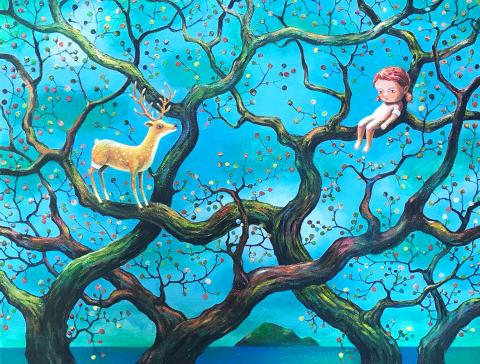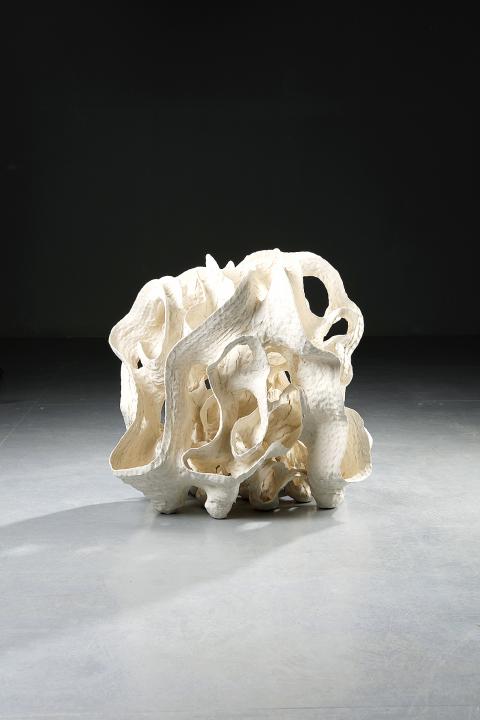Eslite Gallery presents One Plus One (壹加壹), a solo show by Taiwanese artist Michael Lin (林明弘). Lin is known for creating monumental painting projects that incorporate Taiwanese textile patterns. He quotes Paris-based art historian Vivian Rehberg when defining painting as “a bounded physical space [in which] one we can settle into and inhabit.” By staging his gigantic paintings at public art institutions, Lin hopes to encourage viewers to reconsider the nature of these public spaces and our relationship to them. His current show at Eslite is a collaborative presentation between himself, Swiss visual artist Beat Streuli, Roan Ching-yue (阮慶岳) and David Yu (余大衛). The show adopts the structure of a montage, in which different narratives are juxtaposed or reconfigured in different arrangements. The show begins with Streuli’s portrait of “Taipei urbanites.” Lin’s textile patterned painting stands erect in the middle of the first room while also serving as a structural support for Streuli’s billboard-size photographs. In the second room, Streuli’s collage and video projection serve as support for Lin’s work on canvas. The show also includes Yu’s display of collected products chosen from the Eslite Bookstore and Roan’s writings. As a whole, the exhibition strives to make “transparent the relationships of the site and locality, contemporary art and business, promotion and publicity.”
■ Eslite Gallery (誠品畫廊), 5F, 11 Songgao Rd, Taipei City (台北市松高路11號5樓), tel: (02) 8789-3388. Open Tuesdays to Sundays from 11am to 7pm
■ Until Nov. 25

Photo Courtesy of Eslite Bookstore
Casting Stones Into Still Water (靜水蕩漾) is a group exhibition that showcases 15 Filipino female artists. The show is curated by Patrick Flores, an art professor at the University of the Philippines and Curator of the Vargas Museum in Manila. For this exhibition, Flores asked the artists to respond to an installation that Filipino artist Ileana Lee created in the 70’s. In that work, Lee explores the exhibition space by neatly placing strips of tape onto the floor, walls and ceiling, creating contours that mark different areas and conceptually “claim space for the woman artists in the art world,” writes the gallery in a press release. The artists in this show were encouraged to reflect on the issue of boundaries and the claiming of space. Nana Buxan’s Jason Roxas/Marble Worker is a photo of a manual worker whose eyes are covered by powder and face partially covered by a knit hat and mask. Marina Cruz works with painting and embroidery to examine domestic spaces. She focuses on mundane chores like cooking and doing laundry, which according the curator, involves the dynamic relationship between the interior and exterior.
■ Mind Set Art Center (安卓藝術) 108, Heping E Rd, Taipei City (台北市和平東路108號), tel: (02) 2365-6008. Open Tuesdays to Saturdays from 11am to 6pm
■ Until Dec. 8

Photo Courtesy of Double Square Gallery
Hsu Yung-hsu is a Taiwanese ceramic artist with a background in Chinese zither music. Working as an elementary school teacher in the 70s, Hsu founded his own ceramic studio in the 80’s and eventually left his teaching job and music career to become a full-time artist in the late 90’s. In the last three decades, Hsu “steadfastly nurtured a symbiotic union between himself and clay as well as the depth of their dialogue to create his unique sculptural style,“ according to the gallery’s press release. His current show, Unfettered Encompassment (大器逍遙), presents 25 sculptures created in the last four years. Hsu’s work involves a laborsome process of treating clay, where he “constantly and repeatedly presses, compresses, squeezes, tears, pinches, pokes, rubs, piles and pushes to create desired shapes before layering them up to form his sculptures,” writes the gallery. The resulting work is covered with countless hand prints, a testament to his intimate struggle and dialogue with his material. The shape of Hsu’s sculptures suggests organic forms such as sea creatures, ribbon-like fiber, shells or rice husks.
■ Double Square Gallery (雙方藝廊), 28, Lane 770, Beian Road, Taipei City (台北市北安路770巷28號), tel: (02) 8501-2138. Open Tuesdays to Sundays from 10:30am to 6:30pm
■ Until Dec. 8

Photo Courtesy of Taipei Art Village
Jungle (叢林) is a group exhibition that uses the jungle as a metaphor for the state of modern city living. Curated by artist Ni Hao (倪灝), the show includes the works of 10 artists who together tackle the many issues concerning 21st century technology, social history, virtual spaces and the developments of globalization. “From Singapore’s shores to its nocturnal zoo; [from] an abandoned mine in upstate New York to cyber space; [from] military dependents’ villages in Pingtung to Rwanda, [from] Latin America and beyond… artists in this show investigate a common sense of displacement, confusion and entrapment,” writes Ni. The show is a selection of paintings, drawings, photos, installation, sculptures and videos that share the perspective of different social dimensions, including that of a flight attendant, peace keeper, domestic helper, post-apocalyptic data miner, oil painter and surveillance camera. American artists Maggie Hazen and Chris Papa present a collaborative film that narrates the story of a survivor in a post-apocalypse world searching for the remaining traces of humanity. Mark Nilsson’s paintings are a reflection of his experience in Taiwan, especially his area of residence, Chaozhou in Pingtung County. “Working from life, and painting fast with full-bodied paint, I make repeated trips to such places, painting the relevant people, places and things,” writes the artist.
■ Barry Room, Taipei Artist Village (台北國際藝術村百里廳), 7 Beiping E Rd, Taipei City (台北市北平東路7號), tel: (02) 3393-7377. Open Tuesdays to Sundays from 11am to 9pm
■ Until Nov. 25

Photo Courtesy of Mind Set Art Center
Jimmy Liao, known by his pen name Ji Mi (幾米), is a popular illustrator who became a household name in Taiwan during the late 90’s. Before becoming a full-time illustrator and writer, Liao spent 12 years working in advertising. A cancer diagnosis and experience with chemotherapy led him to eventually change his outlook on life. Liao has described drawing as therapy, which he says relaxes him. Over the last two decades, Ji Mi has published over 60 works, many of which have been recognized by international awards and adapted into commercial movies and plays. Many of his stories have also inspired public art projects, including Taipei’s Nangang MRT Station and the Moon Bus, a revamped vehicle stationed across from Taipei 101. To celebrate the 20th anniversary of Ji Mi’s first publication, a selection of his original drawings, paintings and sculptures are on view at Eslite Xinyi Bookstore starting tomorrow. A book compilation of more than 50 of his works will also be available at the bookstore. Be sure to catch the book-signing event scheduled for this Sunday from 3pm to 5pm.
■ Eslite Xinyi Bookstore 6F Multifunctional Hall (誠品信義店 6F展演廳), 11, Songgao Rd, Taipei City (台北市信義區松高路11號), tel: (02) 8789-3388. Open Daily from 11am to 9:30pm.
■ Until Nov. 25

The 1990s were a turbulent time for the Chinese Nationalist Party’s (KMT) patronage factions. For a look at how they formed, check out the March 2 “Deep Dives.” In the boom years of the 1980s and 1990s the factions amassed fortunes from corruption, access to the levers of local government and prime access to property. They also moved into industries like construction and the gravel business, devastating river ecosystems while the governments they controlled looked the other way. By this period, the factions had largely carved out geographical feifdoms in the local jurisdictions the national KMT restrained them to. For example,

The remains of this Japanese-era trail designed to protect the camphor industry make for a scenic day-hike, a fascinating overnight hike or a challenging multi-day adventure Maolin District (茂林) in Kaohsiung is well known for beautiful roadside scenery, waterfalls, the annual butterfly migration and indigenous culture. A lesser known but worthwhile destination here lies along the very top of the valley: the Liugui Security Path (六龜警備道). This relic of the Japanese era once isolated the Maolin valley from the outside world but now serves to draw tourists in. The path originally ran for about 50km, but not all of this trail is still easily walkable. The nicest section for a simple day hike is the heavily trafficked southern section above Maolin and Wanshan (萬山) villages. Remains of

With over 100 works on display, this is Louise Bourgeois’ first solo show in Taiwan. Visitors are invited to traverse her world of love and hate, vengeance and acceptance, trauma and reconciliation. Dominating the entrance, the nine-foot-tall Crouching Spider (2003) greets visitors. The creature looms behind the glass facade, symbolic protector and gatekeeper to the intimate journey ahead. Bourgeois, best known for her giant spider sculptures, is one of the most influential artist of the twentieth century. Blending vulnerability and defiance through themes of sexuality, trauma and identity, her work reshaped the landscape of contemporary art with fearless honesty. “People are influenced by

Ten years ago, English National Ballet (ENB) premiered Akram Khan’s reimagining of Giselle. It quickly became recognized as a 21st-century masterpiece. Next month, local audiences get their chance to experience it when the company embark on a three-week tour of Taiwan. Former ENB artistic director Tamara Rojo, who commissioned the ballet, believes firmly that if ballet is to remain alive, works have to be revisited and made relevant to audiences of today. Even so, Khan was a bold choice of choreographer. While one of Britain’s foremost choreographers, he had never previously tackled a reimagining of a classical ballet, so Giselle was